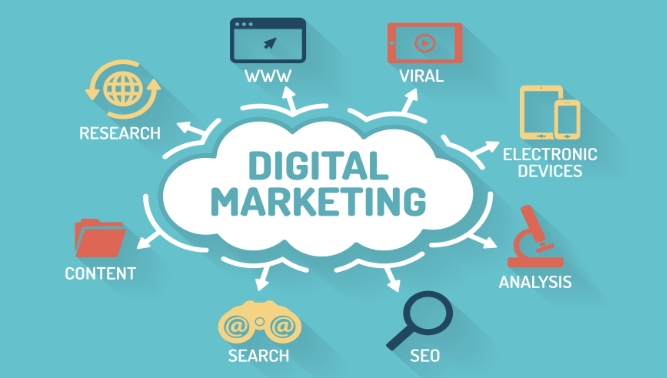Digital Marketing: The Key to Success in the Digital Age
In today’s digitally driven world, simply having a website is no longer enough. Digital marketing has emerged as the essential strategy for businesses to efficiently promote and sell their products and services online.

The Evolution of Consumer Engagement
Modern consumers demand seamless, personalized experiences. A 2023 Pew Research study revealed that 72% of American shoppers begin their purchasing journey with online research, comparing prices, reading reviews, and seeking recommendations on platforms like Google, YouTube, or TikTok. This shift underscores the need for businesses to meet customers where they are—whether through targeted social media ads, email campaigns, or optimized search engine results.
For instance, small businesses in sectors like retail or hospitality have seen success using geo-targeted ads to attract local customers, while e-commerce brands rely on AI-powered product recommendations to boost conversion rates. The key lies in creating a cohesive omnichannel presence that guides users from awareness to purchase without friction.
Core Strategies for Digital Dominance
-
Search Engine Optimization (SEO):With Google processing over 8.5 billion daily searches, visibility on search engines remains critical. Effective SEO combines keyword optimization, high-quality content, and technical improvements to rank higher. Tools like Google Analytics and SEMrush help businesses track performance and adjust strategies in real time.
-
Social Media Mastery:Platforms like Instagram and LinkedIn now serve as hybrid spaces for brand storytelling, customer service, and direct sales. Short-form video content, such as TikTok or Reels, generates 3x higher engagement than static posts, making it a priority for brands targeting Gen Z and Millennials.
-
Email Marketing & Automation:Despite newer trends, email retains a 42:1 ROI according to DMA. Automated workflows—like abandoned cart reminders or personalized birthday offers—enable businesses to nurture leads efficiently while reducing manual effort.
Data: The Backbone of Decision-Making
The true power of digital marketing lies in its measurability. Platforms provide granular insights into click-through rates, customer demographics, and conversion pathways, allowing companies to allocate budgets strategically. For example, A/B testing landing pages or ad creatives can increase conversion rates by up to 50%, as demonstrated by case studies from SaaS companies like HubSpot.
However, rising data privacy regulations (e.g., California’s CCPA) and Apple’s iOS tracking restrictions require marketers to balance personalization with transparency. First-party data collection, such as incentivized surveys or loyalty programs, is becoming a safer, long-term solution.
Challenges and Future Trends
While digital marketing offers unprecedented opportunities, it also poses challenges. Ad saturation has led to "banner blindness," with users increasingly ignoring generic promotions. Brands must prioritize authenticity—66% of consumers now value "trust-building content" over hard sells, per Edelman research.
Emerging technologies will shape the next era:
-
AI and Machine Learning: Tools like ChatGPT are revolutionizing content creation and chatbots, enabling 24/7 customer interaction.
-
Voice Search Optimization: By 2025, 75% of U.S. households are projected to own smart speakers, necessitating SEO strategies for conversational queries.
-
Augmented Reality (AR): IKEA’s AR app, which lets users visualize furniture in their homes, hints at immersive shopping experiences becoming mainstream.
Conclusion
Digital marketing is no longer optional—it’s the cornerstone of modern business survival. By combining agile strategies, ethical data practices, and emerging technologies, companies can build lasting relationships with audiences and stay ahead in a fast-evolving landscape. As the digital ecosystem grows more complex, adaptability and customer-centricity will separate industry leaders from the rest.
Hot Articles

Break Barriers to Homeownership: No Down Payment, No-Income Verification Mortgages Available Now!

Unlocking Affordable 1-3 Bedroom Apartment Options

Secure Your American Education: 90% More Scholarships Available – Apply for Free Today!

El análisis de datos en la era digital: cómo transforma nuestra vida y decisiones